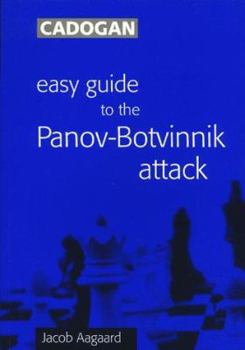Easy Guide to the Panov-Botvinnik Attack
Select Format
Select Condition 
Book Overview
The Panov-Botvinnik Attack is a strong, classical attacking system for White against the Caro-Kann: White develops quickly and attacks the centre, putting immediate pressure on the black position.By... This description may be from another edition of this product.
Format:Paperback
Language:English
ISBN:1857445635
ISBN13:9781857445633
Release Date:January 1998
Publisher:Everyman Chess
Length:128 Pages
Weight:0.40 lbs.
Dimensions:0.4" x 5.8" x 8.3"
Customer Reviews
4 ratings
This book will help you beat (well, draw with) GMs!
Published by Thriftbooks.com User , 24 years ago
Let me tell you a story. I'd been looking for a long time for ways to liven up my play against the Caro-Kann. I was dissatisfied with the Classical Variation (3Nc3), but at the same time was afraid to take on the IQP inherent in the Panov-Botvinnik. Then this book was published and it gave me the confidence to have a go. The result, in about my third of fourth outing with the Panov-Botvinnik, was a draw with Grandmaster Tukmakov (2585) at Lausanne, Switzerland. This was in May 1999 when my FIDE rating was 2096 - almost 500 points lower than his. Much - most? - of the credit belongs to Aagaard's book. He doesn't try to get you to memorise long lines of moves - rather, he teaches ideas. It would be going too far to call it a comprehensive manual on the IQP, but I'm sure it would improve most people's abilities at handling IQP middlegames, as well as possible resulting endgames. My game against Tukmakov will probably not prove atypical. The GM didn't follow one of the main lines discussed by Aagaard, but from what I'd learned I was able to come up with perfectly reasonable moves. Unknown to me - but I'm sure appreciated by my opponent - we transposed to a line from the Karpov-Kamsky FIDE world championship match, which is in the book. The result was a messy sac by me which Tukmakov was unable to refute over the board, and he eventually acquiesced to a perpetual. I was, to put it mildly, well-chuffed (although I've since become a little more realistic about my achievment on finding numerous flaws in the game at home). Anyway, this has been a very personalised review, but I wanted to get across what this book has done for my game - and could do for others'.
original, brilliant piece of work
Published by Thriftbooks.com User , 25 years ago
Aagaard has managed to fill a huge gap in opening literature in a very convincing manner. For all those who want to take up the Panov, this is THE book. What I like most is the highly original style of analysing and writing, and the critical approach towards existing conventions. Aagaard starts each chapter with a number of model games and standard manoeuvres, yet also gives instructive examples where both players went wrong. The highlight of the book is for me the analyses of the endgame in the ...Nc6 line. Having struggled in numerous Caro-Kann games with the question of how to create a lively position on the board, this book definitely has increased my appetite again to take on this opening.
Simply the best there is ...
Published by Thriftbooks.com User , 25 years ago
This book is in the same series as Easy Guide to the Nimzo Indian which I reviewed and did not take a shine to. Well, this volume is much better. The introductions are excellent - we are told how the play should develop, whether we should look to the endgame for superiority or go for broke in the middlegame. The practical examples are current. Layout, diagrams and print are excellent. Aagaard is free with his opinions - which I like - and the piece/pawn patterns for both sides are very useful. Good stuff; I await more from his eloquent pen!
Excellent coverage of the Panov. Caro-Kann players look out!
Published by Thriftbooks.com User , 25 years ago
Knowledge of the Panov-Botvinnik Attack is vital whenever playing openings like Caro-Kann, Nimzo-Indian or the Tarrasch defence. In his book, it seems that Jacob Aagaard has not only collected the most important games and variations in this line. He has also put down great effort explaining what is really going on in the critical positions. The book reaches its peak in the chapter on the well-known endgame that arises in the Nc6-variation. I have never before seen such detailed information about where to put the pieces in this endgame! What also strikes me, reading through this book, is the personal style of the author. No dry, stereotypical comments of the traditional kind is to be found here, believe me. As an example, he is right away making clear what he thinks of the different sidelines, e.g. the g6-variation is not to be recommended for black, and so on. Finally, the fact that this line gives rise to some really appealing positions for the attacking player, makes me want to recommend the book even more.




